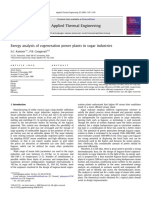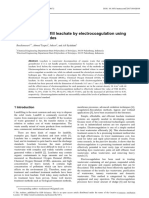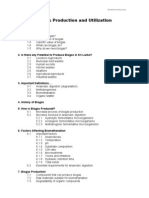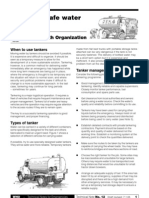Treatment of Sugar Industry Wastewater Using
Treatment of Sugar Industry Wastewater Using
Copyright:
Available Formats
Treatment of Sugar Industry Wastewater Using
Treatment of Sugar Industry Wastewater Using
Original Description:
Copyright
Available Formats
Share this document
Did you find this document useful?
Is this content inappropriate?
Copyright:
Available Formats
Treatment of Sugar Industry Wastewater Using
Treatment of Sugar Industry Wastewater Using
Copyright:
Available Formats
IJRET: International Journal of Research in Engineering and Technology eISSN: 2319-1163 | pISSN: 2321-7308
__________________________________________________________________________________________
IC-RICE Conference Issue | Nov-2013, Available @ http://www.ijret.org 262
TREATMENT OF SUGAR INDUSTRY WASTEWATER USING
ELECTROCOAGULATION TECHNIQUE
C.B.Shivayogimath
1
, Rashmi Jahagirdar
2
1
Professor and Head,
2
M.Tech Scholar, Department of Civil Engineering, Basaveshwar Engineering College, Bagalkot,
Karnataka, India, rjahagirdar26@gmail.com
Abstract
The cost effective treatment of sugar industry wastewater is a challenging task. In the present work, an attempt was made for the
treatment of sugar industry wastewater using electrocoagulation technique with iron electrodes as sacrificial anode in bipolar
connection system. The effects of operating parameters such as pH, voltage and electrolysis duration on the removal of COD and
turbidity were investigated. The optimum value for each operating variable was experimentally determined. The optimum values of
voltage, initial pH and electrolysis time were found to be 12V, 6.0 and 4 hours respectively. The experiments revealed that COD and
turbidity in aqueous phase was effectively removed. The analysis of the treated water showed that the maximum COD and turbidity
removal efficiencies were 92.8% and 92.4% respectively at optimum conditions. The effluent was very clear and its quality meets the
discharge standard. Consequently, the electrocoagulation process can be considered as a reliable, safe and cost effective method for
the treatment of sugar industry wastewater.
Keywords: Electrocoagulation, sugar industry wastewater, electrolysis time, voltage, COD, turbidity.
----------------------------------------------------------------------***-----------------------------------------------------------------------
1. INTRODUCTION
India is one of the largest producers and consumers of 22
million tones of sugar per annum in the world and about
1000L of wastewater is produced for every ton of cane
crushed [1]. Because of high BOD content, sugar industry
wastewater lead to the depletion of dissolved oxygen content
in the water bodies resulting if discharged untreated, rendering
the water bodies unfit for both aquatic and human uses [2]. If
untreated wastewater is discharged on land, decaying organic
solids present in the wastewater clog the soil pores [3].
Rapid urbanization, industrialization and population growth
have led to the severe contamination of most of the fresh water
resources with untreated industrial and municipal wastes [4].
Treatment and reuse of wastewaters have become absolute
necessity to avoid pollution of fresh water bodies [5]. Hence
purification of sugar industry wastewater is a challenging task
due to the stringent discharge standards for the protection of
environment.
Sugar industry effluent is conventionally treated by adopting
various physico-chemical and biological methods. These
conventional processes suffer the disadvantage that the reagent
costs are high and the soluble COD removal is low. Moreover,
chemical treatments could induce a secondary pollution due to
the fact that chemical additives may contaminate the treated
water [6]. Coagulants in addition to increasing the amount of
sludge production increase the total solids in the effluents;
adsorption process necessitates back-washing and use of
membranes has the problem of scaling and frequent membrane
fouling [7]. Conventional biological treatment systems for
sugar factory wastewaters may not be feasible due to large
land space requirement as well as high capital and operational
cost [8]. Hence electrochemical treatment of sugar industry
wastewater may be considered as an economical alternative
process when conventional treatment methods fail to reduce
pollution. The EC technique has been successfully used for the
treatment of various wastewaters such as domestic wastewater
[9], cyanide containing wastewater [10], tannery wastewater
[11], textile wastewater [12], slaughter-house wastewater [13]
etc. Hence in the present study an attempt was made on the
evaluation of the efficiency of the electrocoagulation process
on treatment of sugar industry wastewater using iron
electrodes.
1.1 Theory of Electrocoagulation:
Electro coagulation (EC) is a process in which the anode
material undergoes oxidation with formation of various
monomeric and polymeric metal hydrolyzed species. These
metal hydroxides remove organics from wastewater by sweep
coagulation and/or by aggregating with the colloidal particles
present in the wastewater to form bigger size flocs which
ultimately are removed by settling [14]. During EC,
coagulants are obtained in situ by the dissolution of the anode.
In this process if M is considered as anode, the following
reactions will occur [15]:
IJRET: International Journal of Research in Engineering and Technology eISSN: 2319-1163 | pISSN: 2321-7308
__________________________________________________________________________________________
IC-RICE Conference Issue | Nov-2013, Available @ http://www.ijret.org 263
At the anode:
M
(S)
M
n+
(aq)
+ ne
-
(1)
2H
2
O
(l)
4H
+
(aq)
+ O
2 (g)
+ 4e
-
(2)
At the cathode:
M
n+
(aq)
+ ne
-
M
(S)
(3)
2H
2
O
(l)
+ 2e
-
H
2 (g)
+2OH
-
(4)
Freshly formed amorphous M(OH)
3
has large surface areas
that are beneficial for rapid adsorption of soluble organic
compounds and trapping of colloidal particles.
2. MATERIALS AND METHODS
For the batch electrocoagulation, the reactor made up of
plastic material with the dimensions of 14cm x 9cm x 15cm
was used. The working volume of the reactor was 1L. The EC
unit consisted of four iron electrodes connected as bipolar
system in the reactor and DC power supply. The dimensions
of the electrodes were 5cm x 5cm x 1mm. The schematic
representation of the experimental setup is shown in Fig 1.
After the initial characterization of wastewater, batch
experimental studies were conducted to optimize the various
parameters such as pH, electrolysis time (ET) and voltage.
Experiments were performed with two electrodes connected to
the DC power supply to determine optimum conditions. In the
bipolar connection of electrodes, there is no electrical
connection between inner electrodes; only the outer electrodes
are connected to the power supply. The space between the four
electrodes was maintained 1cm in all the experiments. In each
run the voltage was varied to a desired value of 8, 10 and 12V.
To maintain homogenous mixing of the reactor content,
magnetic stirring unit is used. The wastewater concentration
was reduced to half the strength throughout the study to
reduce the time and current consumption and to obtain better
efficiency. The EC experiments were performed for 5 hours
and in each run samples were collected at every one hour
interval for necessary analysis.
Fig 1: Schematic representation of the Experimental Set-up
3. RESULTS AND DISCUSSION
Wastewater sample was collected from the nearest sugar
industry and was characterized for quality parameters. The
various parameters of wastewater are shown in Table 1.
Table 1: Characteristics of Sugar industry Wastewater
Sl No. Parameters Values
1. pH 5.1
2. Color Greenish
Yellow
3. Turbidity 249.1 NTU
4. Suspended solids 380 mg/L
5. BOD
5
2250mg/L
6. COD 6400 mg/L
7. Total Dissolved
solids
1008 mg/L
8. Nitrate 6.2mg/L
9. Phosphate 0.8mg/L
The study was mainly focused on the electrocoagulation of the
sugar industry wastewater with high concentration of COD for
determining effects of operating parameters such as pH,
voltage and electrolysis time on COD and turbidity removal.
IJRET: International Journal of Research in Engineering and Technology eISSN: 2319-1163 | pISSN: 2321-7308
__________________________________________________________________________________________
IC-RICE Conference Issue | Nov-2013, Available @ http://www.ijret.org 264
Initially, the experiment was carried out without adjusting pH
of raw wastewater at pH 5 with varying voltages. The COD
reduced from 6400mg/L to 2080, 1440 and 1120 mg/L thereby
giving 67.5%, 77.5% and 82.5% COD removal efficiencies
respectively for 8V, 10V and 12V at 4 hours (Fig 2).
However, the COD removal efficiencies remained same for 5
hours of electrolysis time. The turbidity reduced from 92 NTU
to 27, 21.5 and 15 NTU thereby being 70.67%, 76.82%,
83.49% efficient in removing turbidity from wastewater
respectively for 8V, 10V and 12V at 4 hours (Fig 3). The
turbidity removal efficiencies also did not change further for 5
hours of electrolysis duration.
Fig 2: COD removal vs time at different voltages at pH 5
Fig 3: Turbidity removal vs time at different voltages at pH 5
Next the experiment was carried out by increasing pH to 6.0
with different voltages 8V, 10V and 12V and maximum COD
removal efficiencies of 72.5%, 85% and 92.8% respectively
were obtained for 4 hours (Fig 4) which remained constant for
5 hours of electrolysis time. Similarly, maximum turbidity
removal efficiencies of 78.91%, 84.68% and 92.4% for 4
hours (Fig 5) were obtained.
Fig 4: COD removal vs time at different voltages at pH 6
Fig 5: Turbidity removal vs time at different voltages at pH 6
When experiment was carried out by further increasing the pH
to 7.0 with varying voltages 8V, 10V and 12V, the maximum
COD removal efficiencies were found to be 70%, 82.5% and
87.5% respectively for a duration of 4 hours (Fig 6) and
remained unchanged for 5 hours of electrolysis time.
Similarly, the maximum turbidity removal efficiencies
obtained were 72.4%, 80.09% and 88.76% for 4 hours of ET
(Fig 7).
Fig 6: COD removal vs time at different voltages at pH 7
IJRET: International Journal of Research in Engineering and Technology eISSN: 2319-1163 | pISSN: 2321-7308
__________________________________________________________________________________________
IC-RICE Conference Issue | Nov-2013, Available @ http://www.ijret.org 265
Fig 7: Turbidity removal vs time at different voltages at pH 7
From the above analysis, it was found that maximum COD
removal efficiency 92.8% and turbidity removal of 92.4%
were obtained at optimum operating parameters of pH 6, 12V
and 4 hours of electrolysis duration. At these operating
conditions COD reduced from 6400 mg/L to 460 mg/L and
turbidity reduced from 92 NTU to 7 NTU.
CONCLUSIONS
Based on the experimental findings, the electrolysis duration
of 4 hours, pH 6.0 and 12V were found to be the critical
operating parameters for the treatment of wastewater using
iron as electrode material. Maximum COD removal of 92.8%
and turbidity removal of 92.4% were obtained at these
optimum operating conditions. Hence, it can be concluded that
the electrocoagulation technology using iron electrodes
appears to be a feasible alternative for the treatment of sugar
industry wastewater. Thus electrocoagulation is an efficient
process for treatment of sugar industry wastewater which is
fast, easy, and economical and can be operated using less
equipment and limited space.
REFERENCES:
[1]. P.Asaithambi, Manickam Matheswaran, 2011,
Electrochemical treatment of simulated sugar industrial
effluent: Optimization and modeling using a response surface
methodology, Arabian Journal of Chemistry.
[2]. Hampannavar U.S and Shivayogimath C.B., 2010,
Anaerobic treatment of sugar industry wastewater by Upflow
anaerobic sludge blanket reactor at ambient temperature,
International journal of environmental sciences, Volume 1
No.4,631-639.
[3]. Technology information, forecasting and assessment
council, Department of science and technology, Government
of India, 2009.
[4]. Muhammad Saleem, Alaadin A. Bukhari and Muhammad
Noman Akram, 2011, Electrocoagulation for the treatment of
wastewater for reuse in irrigation and plantation, Journal of
basic and applied sciences,Vol. 7, No.1, 11-20.
[5]. Moh Faiqun Niam, Fadil Othman, Johan Sohaili, Zulfa
Fauzia,2007, Removal of COD and turbidity to improve
wastewater quality using electrocoagulation technique, The
Malaysian Journal of Analytical Sciences, Vol 11, No1:198-
205.
[6]. Serge Tchamango, Charles P. Nanseu-Njiki, Emmanuel
Ngameni, Dimiter Hadjiev, Andre Darchen, 2010, Treatment
of dairy effluents by electrocoagulation using aluminium
electrodes, Science of the total environment 408, 947-952.
[7]. M.Malakootian, N.Yousefi, 2006, The efficiency of
electrocoagulation process using aluminium electrodes in
removal of hardness from water, Iranian Journal
Environmental Health Science Engineering, Vol.6, No.2, pp
131-136.
[8]. Guray Guven, Altunay Perendeci, Abdurrahman
Tanyolac, 2009, Electrochemical treatment of simulated beet
sugar factory wastewater, Chemical Engineering Journal
151,149-159.
[9]. Ugur Kurt, M.Talha Gonullu, Fatih Ilhan, Kamil Varinca,
2008, Treatment of Domestic wastewater by
electrocoagulation in a cell with Fe-Fe electrodes,
Environmental Engineering Science, Vol 25, No. 2,153-161.
[10]. G.Moussavi, F.Majidi and M.Farzadkia, 2011, Removal
of Cyanide from wastewater using the electrocoagulation
process, Proceedings of the 12
th
International Conference on
Environmental Science and Technology, Rhodes, Greece.
[11]. R.Ramesh Babu, N.S.Bhadrinarayana, K.M.Meera
Sheriffa Begum, N. Anantharaman, 2007, Treatment of
tannery wastewater by electrocoagulation, Journal of the
University of Chemical technology and metallurgy, 42, 2,
2007, 201-206.
[12[. Mehmet Kobya, Orhan Taner Can, Mahmut
Bayramaoglu, 2003, Treatment of textile wastewaters by
electrocoagulation using iron and aluminium electrodes,
Journal of hazardous materials, 163-178.
[13[. Budiyono, I.N. Widiasa and Seno Johari, 2010, Study on
treatment of Slaughterhouse wastewater by electrocoagulation
technique, International Journal of Science and Engineering,
Vol.1 (1): 25-28.
[14]. M.A.Abd El-Khalek, 2011, Studies on Industrial
wastewater treatment by electrochemical coagulation, The
Journal of Ore-dressing, 15-20.
[15]. Anchalee Srirangsan, Maneerat Ongwandee and Orathai
Chavalparit, 2009, Treatment of Biodiesel wastewater by
electrocoagulation process, Environment Asia, 15-19.
You might also like
- Lievito MadreDocument10 pagesLievito Madrekkd108100% (1)
- Electrolyser Case Studies (COMPARATIVA ELECTROLIZADORES)Document26 pagesElectrolyser Case Studies (COMPARATIVA ELECTROLIZADORES)RaulNo ratings yet
- Manual For FLue Gas Analyzer E4400Document72 pagesManual For FLue Gas Analyzer E4400Mohit MalikNo ratings yet
- Effect of Cement, Limestone and Hydrated Lime On Setting Time and Compressive Strength of Local GypsumDocument13 pagesEffect of Cement, Limestone and Hydrated Lime On Setting Time and Compressive Strength of Local GypsumRajNo ratings yet
- Draft CommanderDocument5 pagesDraft CommanderUSFireEquipmentNo ratings yet
- Chemical Process Equipment DesignDocument9 pagesChemical Process Equipment Designraghu_iictNo ratings yet
- Co-Precipitation 1 - AlFe2O4 and MgFe2O4 Biogass Sugar Refinery ADDocument7 pagesCo-Precipitation 1 - AlFe2O4 and MgFe2O4 Biogass Sugar Refinery ADMahmoud MazarjiNo ratings yet
- Project Reff. - PT Weltes Energi NusantaraDocument72 pagesProject Reff. - PT Weltes Energi NusantaraMuhammad Indra ArifiantoNo ratings yet
- Astm F952 12Document6 pagesAstm F952 12Yasir NASSERALLAHNo ratings yet
- WASP Interface TutorialDocument35 pagesWASP Interface Tutorialblacklist_number9No ratings yet
- Convection Heat Transfer in Baffled Mixing TankDocument7 pagesConvection Heat Transfer in Baffled Mixing Tankfujiman35No ratings yet
- Biogas by Landhi FarmDocument74 pagesBiogas by Landhi Farmmogame100% (3)
- Non NewtonianDocument14 pagesNon NewtonianLuis Felipe Gutierrez MarcantoniNo ratings yet
- Block Diagram of A Chemical-Reactor Control SystemDocument13 pagesBlock Diagram of A Chemical-Reactor Control Systemکبری ادریس رسولNo ratings yet
- Cyclohexane Storage Tank (T-102) : Technological Institute of The PhilippinesDocument18 pagesCyclohexane Storage Tank (T-102) : Technological Institute of The PhilippinesEUNICE ANGELA LASCONIANo ratings yet
- Beneficiation of Azara Barite Ore Using A Combination of Jigging, Froth Flotation and LeachingDocument6 pagesBeneficiation of Azara Barite Ore Using A Combination of Jigging, Froth Flotation and LeachingPhilips UchennaNo ratings yet
- Assessment of The Toxicity of Waste Water From A Textile Industry To Cyprinus CarpioDocument6 pagesAssessment of The Toxicity of Waste Water From A Textile Industry To Cyprinus CarpioGustavo ValdebenitoNo ratings yet
- Reynolds NumberDocument18 pagesReynolds NumberArvindaLallNo ratings yet
- The Use of Simulink For Process Modelling in The Sugar IndustryDocument13 pagesThe Use of Simulink For Process Modelling in The Sugar Industrymarcio_limaNo ratings yet
- Exploration KerinciDocument6 pagesExploration KerinciNovia Pirma Yeni PirdausNo ratings yet
- The Feasibility of Short Term Production Strategies For Renewable Jet FuelsDocument23 pagesThe Feasibility of Short Term Production Strategies For Renewable Jet FuelsTéfo OliveiraNo ratings yet
- Final ExamDocument6 pagesFinal ExamTej ChoksiNo ratings yet
- Luke Is God SpreadsheetDocument10 pagesLuke Is God SpreadsheetAndrew PeterNo ratings yet
- Soal Internal Competition - Kunci JawabanDocument9 pagesSoal Internal Competition - Kunci JawabanMahasinul FathaniNo ratings yet
- Recycle Structure of The FlowsheetDocument19 pagesRecycle Structure of The FlowsheetSanyog GhoshNo ratings yet
- Sikagard 63n PdsDocument4 pagesSikagard 63n PdsHendro YuniantoNo ratings yet
- Semiconductor Wastewater Treatment Using Tapioca Starch As A Natural CoagulantDocument9 pagesSemiconductor Wastewater Treatment Using Tapioca Starch As A Natural Coagulanthuonggiangnguyen3011No ratings yet
- Exergy AnalysisDocument8 pagesExergy AnalysisNikhil MohiteNo ratings yet
- Treatment of Sugar Industry WastewaterDocument4 pagesTreatment of Sugar Industry WastewaterLuu TonyNo ratings yet
- Ce2356-Environmental Engineering Lab: Department of Civil EngineeringDocument50 pagesCe2356-Environmental Engineering Lab: Department of Civil Engineeringjss_devNo ratings yet
- A Structured Approach To Sugar Factory DesignDocument14 pagesA Structured Approach To Sugar Factory DesignREMINGTON SALAYANo ratings yet
- LITERATURE REVIEW Exp 6Document3 pagesLITERATURE REVIEW Exp 6Meenakchi Anuradha100% (2)
- Progress Report For Poly (Acrylonitrile-Arcylic Acid) AmidoximeDocument18 pagesProgress Report For Poly (Acrylonitrile-Arcylic Acid) AmidoximeamirahNo ratings yet
- CFD Simulation of Boiling Flows Using The Volume-Of-Fluid Method Within OpenFOAM Sir PaperDocument17 pagesCFD Simulation of Boiling Flows Using The Volume-Of-Fluid Method Within OpenFOAM Sir PaperedNo ratings yet
- Simulation of A Tank Fill by Volume of Fluid Method Using Ansys Fluent - Training, Projects & Research CenterDocument9 pagesSimulation of A Tank Fill by Volume of Fluid Method Using Ansys Fluent - Training, Projects & Research CenterHayderAlSamawiNo ratings yet
- ASTM For Proximate Analysis PDFDocument14 pagesASTM For Proximate Analysis PDFRaj Kumar RajuNo ratings yet
- Koya University Faculty of Engineering Chemical Engineering DepDocument10 pagesKoya University Faculty of Engineering Chemical Engineering Depahmed tobaNo ratings yet
- Cement Kiln Dust (CKD) Treated SubgradeDocument4 pagesCement Kiln Dust (CKD) Treated SubgradeDevrim GürselNo ratings yet
- H2S RemovalDocument1 pageH2S RemovalJoanne SalresNo ratings yet
- Kinetic Model of Biomass GasificationDocument7 pagesKinetic Model of Biomass GasificationjuaanxpoonceNo ratings yet
- Liquid CO2 StorageDocument12 pagesLiquid CO2 StorageNguyen Quyet ThangNo ratings yet
- Optimally Economic Design of Flare Systems PDFDocument5 pagesOptimally Economic Design of Flare Systems PDFMedaculoNo ratings yet
- Techno-Economic Assessment About Polyvinyl ChlorideDocument3 pagesTechno-Economic Assessment About Polyvinyl ChlorideIntratec SolutionsNo ratings yet
- Techno-Economic Modelling and Cost Functions of CO Capture ProcessesDocument11 pagesTechno-Economic Modelling and Cost Functions of CO Capture ProcessesAlex Mark100% (1)
- Vohra 2014Document12 pagesVohra 2014Anonymous BAzdPesNo ratings yet
- GT Tray Tower1 PDFDocument12 pagesGT Tray Tower1 PDFJose Christian Viladegut GuzmanNo ratings yet
- API Tech Data Book,: 9 EditionDocument15 pagesAPI Tech Data Book,: 9 EditionHassanNo ratings yet
- ReadmeDocument3 pagesReadmeI. SahbaniNo ratings yet
- Electrochemical Degradation of Remazol Red RB 133 Using Sacrificial ElectrodesDocument23 pagesElectrochemical Degradation of Remazol Red RB 133 Using Sacrificial ElectrodesGlobal Research and Development ServicesNo ratings yet
- Core Sampling Recommended ProceduresDocument16 pagesCore Sampling Recommended ProceduresAgus Wahyu SetiawanNo ratings yet
- Lecture 10 - Steam Condensers - Direct TypeDocument4 pagesLecture 10 - Steam Condensers - Direct TypeHussain AbbasNo ratings yet
- DWSIM Instruction Sheet English PDFDocument2 pagesDWSIM Instruction Sheet English PDFFarhin KhanNo ratings yet
- Plant Design and Economics: Lecture - 5Document39 pagesPlant Design and Economics: Lecture - 5Sky LightsNo ratings yet
- Waste WaterDocument106 pagesWaste WaterLing Li100% (1)
- Adigrat Univeristy: College of Engineering and Technology Department of Chemical Engineering Course Title: Course CodeDocument4 pagesAdigrat Univeristy: College of Engineering and Technology Department of Chemical Engineering Course Title: Course CodeetayhailuNo ratings yet
- Ten Steps To An Effective Bin DesignDocument13 pagesTen Steps To An Effective Bin DesignLeandro BorbaNo ratings yet
- The Isomerization of N-Butane To Iso-Butane Is Car...Document1 pageThe Isomerization of N-Butane To Iso-Butane Is Car...Genta Fauzan0% (1)
- Copia Electrocoagulacion KobyaDocument11 pagesCopia Electrocoagulacion KobyaDario AcevedoNo ratings yet
- Removal of Oil From Biodiesel Wastewater by Electrocoagulation MethodDocument8 pagesRemoval of Oil From Biodiesel Wastewater by Electrocoagulation MethodhusseinhshNo ratings yet
- Treatment of Distillery Spent Wash by AnaerobicDocument4 pagesTreatment of Distillery Spent Wash by AnaerobicInternational Journal of Research in Engineering and TechnologyNo ratings yet
- Matecconf Sicest2017 02010Document6 pagesMatecconf Sicest2017 02010Trecy RezatantiaNo ratings yet
- Treatment of Rice Mill Wastewater Using ContinuousDocument9 pagesTreatment of Rice Mill Wastewater Using ContinuousFarid MadjeneNo ratings yet
- 7640-Article Text-30246-7-10-20210302Document9 pages7640-Article Text-30246-7-10-20210302Siti AmirahNo ratings yet
- Clouds and The Energy Cycle: The Earth Science Enterprise SeriesDocument6 pagesClouds and The Energy Cycle: The Earth Science Enterprise Seriesady_br08No ratings yet
- Wss Brochure Gamazyme-Probiotic-CleanersDocument4 pagesWss Brochure Gamazyme-Probiotic-Cleanersh3nryx02No ratings yet
- Form 2 Syllabus To Be Covered: 10 ChaptersDocument8 pagesForm 2 Syllabus To Be Covered: 10 ChaptersSue YaLeeNo ratings yet
- Biogas Production and UtilizationDocument28 pagesBiogas Production and UtilizationWijetunga Somasiri100% (2)
- Design of Drip Irrigation SystemDocument38 pagesDesign of Drip Irrigation SystemNiiteSajo0% (1)
- Technical Specs ROVsDocument2 pagesTechnical Specs ROVsAlfredo MunarNo ratings yet
- Wadi Hanifah Restoration ProjectDocument4 pagesWadi Hanifah Restoration ProjectThuy Thanh LeNo ratings yet
- Report On Thermal Power PlantDocument22 pagesReport On Thermal Power PlantNitinNo ratings yet
- English Bis5012Document25 pagesEnglish Bis5012Adam AsyrafNo ratings yet
- Disaster Management Plan: WAPCOS LimitedDocument11 pagesDisaster Management Plan: WAPCOS LimitedMallinatha PNNo ratings yet
- CHP Sludge DeterminationDocument5 pagesCHP Sludge DeterminationNkanyezi MazibukoNo ratings yet
- Mekong River - Mother Ganga' of Southeast AsiaDocument17 pagesMekong River - Mother Ganga' of Southeast AsiaUday DokrasNo ratings yet
- Adico NC LDocument2 pagesAdico NC LMuhammad ShuaibNo ratings yet
- Lead Battery RecyclersDocument72 pagesLead Battery RecyclersravishankarNo ratings yet
- 130Document2 pages130Aaron QuinnNo ratings yet
- Activated Carbon ProposalDocument8 pagesActivated Carbon ProposalRenzo Cadag MacasilNo ratings yet
- Finding Dory BookletDocument13 pagesFinding Dory BookletLigia ReyesNo ratings yet
- Airport DrainageDocument20 pagesAirport Drainageaxay shah100% (1)
- Geography of EuropeDocument87 pagesGeography of EuropeRaphael Loga100% (2)
- Tank Cleaning ServiceDocument5 pagesTank Cleaning Servicecontango O&GNo ratings yet
- HomeostasisDocument12 pagesHomeostasishamidi100% (1)
- Micro Irrigation PDFDocument9 pagesMicro Irrigation PDFAVISHKAR AVISHKARNo ratings yet
- Eau Kulen (Part 2) Slide PresentationDocument11 pagesEau Kulen (Part 2) Slide PresentationMeowNo ratings yet
- Arch 320 BTDocument4 pagesArch 320 BTsammyyyyy4No ratings yet
- Presentation On - : Horizontal Centrifugal PumpDocument78 pagesPresentation On - : Horizontal Centrifugal Pumplifemillion2847100% (1)
- Water Tanker DD31C52Ad01Document4 pagesWater Tanker DD31C52Ad01Rohit KhannaNo ratings yet
- Splbe - Master Plumber 2015: C. SinksDocument31 pagesSplbe - Master Plumber 2015: C. SinksXDXDXD100% (2)

























































































